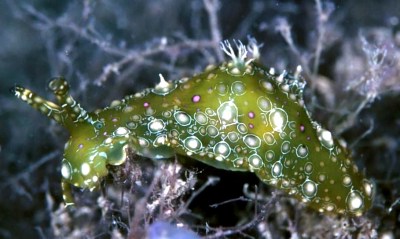
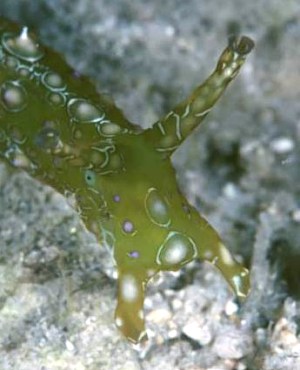
Petalifera ramosa
Baba, 1959
Order: ANASPIDEA
Superfamily: APLYSIOIDEA
Family: Aplysiidae
DISTRIBUTION
Western Pacific and possibly Indian Ocean. Atlantic [Caribbean, and Canary Ids?].
PHOTO
Fly Point, Port Stephens, New South Wales, Australia. In weed in about 5-8 metres on 21 Nov 1999.[5-8cm long] PHOTO: Ron Greer.
This species is characterised by the firm conical tubercles scattered over the body. The smaller ones are often pink with a darker basal ring and the larger ones are a pale brownish white with a dark brown basal ring and often with an outer white ring. Some of the larger tubercles have a terminal papilla which often has long filamentous branches. Baba reports animals growing to between 5-7cm long. It can swim, when disturbed, by dorsoventral flexion of the body.
See Phyllaplysia sp. 1. for a discussion on Petalifera and Phyllaplysia.
Reference: Baba, K. (1959) The genus Petalifera and a new species, P. ramosa, from Japan. Publications of the Seto marine Biological Laboratory, 7(3): 43-44.
• Marcus, Ev. & Er. Marcus. 1962. Opisthobranchs from Florida and the Virgin Islands. Bulletin of Marine Science of the Gulf and Caribbean, 12(3): 450-488.
• Marcus, Ev. 1976. Opisthobranchia von Santa Marta, Colombia. Studies on Neotropical Fauna and Environment, 11: 119-150.
• Thompson, T. E. 1977. Jamaican Opisthobranch Molluscs I. Journal of Molluscan Studies, 43: 93-140.
• Ortea, J. & E. Martínez. 1991. El orden Anaspidea (Mollusca: Opisthobranchia) en las Islas Canarias. Revista de la Academia Canaria de Ciencias, 3(4): 87-107.
• Martínez, E. & J. Ortea. 1992. Primeros datos sobre el orden Anaspidea (Mollusca: Opisthobranchia) en la Isla de Cuba. Revista de Biología de la Universidad de Oviedo 9-10: 95-111.
• Redfern, C. 2001. Bahamian Seashells: a Thousand Species from Abaco, Bahamas.
Note added 19 May 2000: - original images replaced with better coloured slides - see message below.
Authorship detailsRudman, W.B., 1999 (December 2) Petalifera ramosa Baba, 1959. [In] Sea Slug Forum. Australian Museum, Sydney. Available from http://www.seaslugforum.net/find/petaramo
Related messages
Re: Petalifera ramosa with probable eggs [2]
January 12, 2009
From: David and Leanne Atkinson
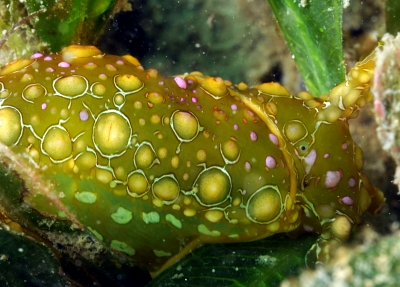
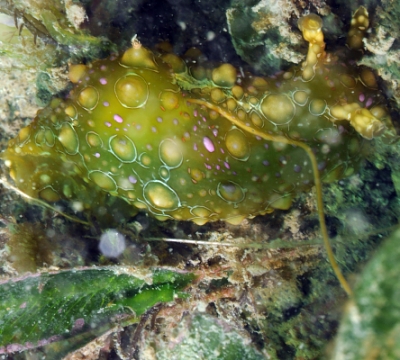
Hi Bill,
Here is the second part of our message concerning the Petalifera ramosa we found laying eggs on New Year's Eve, one green and one brown in a large patch of Halophila. As we describe in the earlier message [#22135], the brown one was clearly laying eggs, its head moving across the leaf in a zigzag pattern. We didn't look closely initially at the photos of the green one because there was a lot of scatter and out of focus leaves due to the green one being so active. We didn't realise that the green one had also started laying eggs but was disturbed by our approach and started to move off leaving a trail of eggs so tiny that we just thought it was part of the tangle of seaweed and algae. It wasn't until we looked closely at the photos on the computer screen that we realised what we had photographed. In the first photo you can see an orange line underneath the groove running from the parapodial cavity in the groove down to the right hand side of the head and back under the foot to the original Halophila leaf it was laying on. In the second photo we can see the eggs remaining attach at the end to the Halophila leaf and being pulled out of the groove as the Petalifera moves away. In the final shot the eggs have been pulled completely out of the groove and are trailing directly out of the reproductive opening, enlargement of the yellow string shows individual eggs. Hopefully the eggs will survive this unusual laying pattern. You can also see the edge of the groove going down the right hand side of the animal's face. We do have more photos of this Petalifera with egg trail that we can send but felt these three showed the process most clearly and didn't want to overwhelm you. Let us know if you need more.
Locality: The Pipeline, Nelson Bay, Port Stephens, 5 metres, New South Wales, Australia, 31 December 2008, Sandy silty bottom with Halophila surrounded by other seaweeds including kelp. Length: 50 mm. Photographer: David and Leanne Atkinson.
Regards,
Leanne & David Atkinson
atk@hunterlink.net.au
Atkinson, D. & L., 2009 (Jan 12) Re: Petalifera ramosa with probable eggs [2]. [Message in] Sea Slug Forum. Australian Museum, Sydney. Available from http://www.seaslugforum.net/find/22137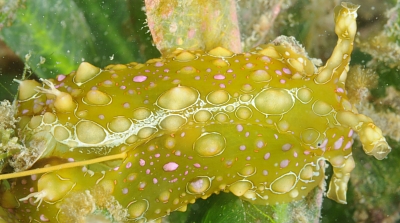
Dear David & Leanne,
Thanks for these photos. I think that even in the uppermost photo the egg string has been pulled, at least partially, out of the sperm groove. What this illustrates though is that calling this groove the 'sperm groove', 'seminal groove' or 'autoseminal groove' - as is the usual practice, is a misnomen. It has the name because it does indeed transport the sperm from the common genital opening in the mantle cavity, down to the penial opening on the right side of the head. However at least in Phyllaplysia - and probably in most aplysiids - it also is the way the egg string passes down to the foot for the deposition of the egg string either in the zigzag pattern of this species or the tangle of most species of Aplysia.
Like many 'discoveries' in science, it is so obvious we have never noticed it before! Unfortunately anatomy is done on preserved specimens and even more unfortunately anatomists are often only interested in structure and tend to have little interest in how the structure functions in the living animal.
Best wishes,
Bill Rudman
Re: Petalifera ramosa with probable eggs [1]
January 12, 2009
From: Leanne & David Atkinson
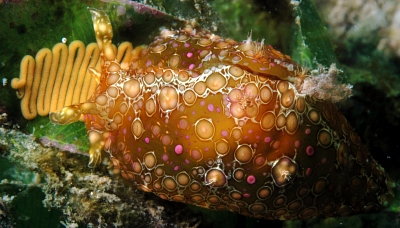
Concerning message #21324:
Hi Bill,
Season's greetings, we found Petalifera ramosa laying eggs on New Year's Eve. There were two animals, one green and one brown in a large patch of Halophila. The brown one was laying eggs. Here is a series of photos showing its head moving across the leaf in a zigzag pattern. We can also see an orange line in the groove running from the parapodial cavity down to the right hand side of the head. Is that the eggs we can see moving down the groove? Sadly the leaf was curved inwards on the right hand side so we couldn't get any clear shots of what was happening on the right hand side of contact with the leaf without disturbing the process.
Locality: The Pipeline, Nelson Bay, Port Stephens, 5 metres, New South Wales, Australia, Pacific, 31 December 2008, Sandy silty bottom with Halophila surrounded by other seaweeds including kelp. Length: 40 mm. Photographer: Leanne and David Atkinson.
Some photos of the green animal are in a separate message [#22137 ]
Regards,
Leanne & David Atkinson
atk@hunterlink.net.au
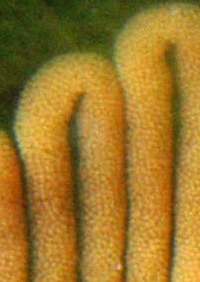
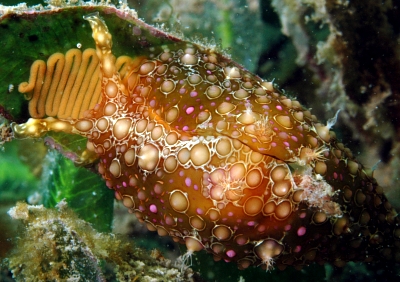
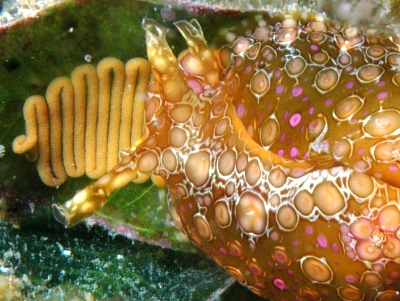
Dear Leanne & David,
Thanks very much for this New Years present. In an earlier message of yours [#21237] I suggest that, as in Phyllaplysia taylori, the egg string is extruded from the common genital opening and travels down the anterior groove we call the external sperm groove. In a close-up of one of your photos we can see the yellow band along the right side of the neck which you describe - the right end of the band is at the common genital opening and the left end disappears down below the head tentacles. As you suspect, this is clearly the egg string doing exactly as described by Robert Beeman for P. taylori. In your message concerning the green animal [#22137 ] - which you disturbed, the photos show the groove and the egg-string very clearly.
So this is one little unknown you can cross off you 'to do' list. Thank you very much.
Best wishes,
Bill Rudman
Re: Petalifera ramosa with probable eggs
February 1, 2008
From: Leanne & David Atkinson
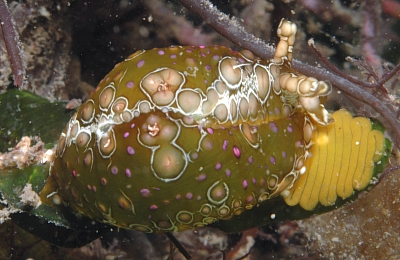
Concerning message #21237:
Dear Bill,
We've been working on that "to do list".
We found what we think is Petalifera ramosa laying eggs. You can see the start of yellow to orange zigzag of eggs under its mouth. We took quite a few photos before it left the Halophila. This doesn't look as long as the one in Ron Greer's shot, think we must have disturbed it with all the flashing and holding the seagrass to get a better shot. There are more photos than we can send in one message so we will send them over a series so your expert eye can pick the ones that show the process best. They do show that the Petalifera was moving its head from one side of the leaf to the other. You can also see that the zigzag of eggs has grown during the sequence of photos.
Locality: The Pipeline, Port Stephens, 8 metres, New South Wales, Australia, Pacific, 22 December 2007, Sandy silty bottom with scattered seagrass, sponges, ascidians, bryozoans, soft corals and gorgonians.. Length: 40 mm. Photographer: Leanne & David Atkinson.
Best wishes,
Leanne & David Atkinson
atk@hunterlink.net.au
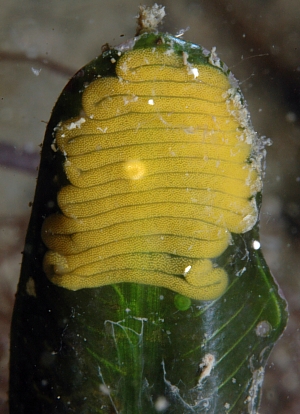
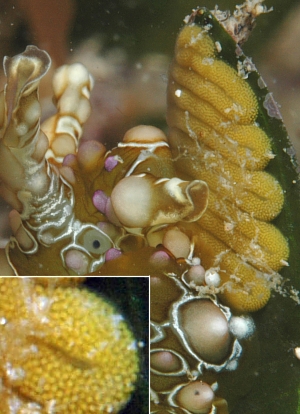
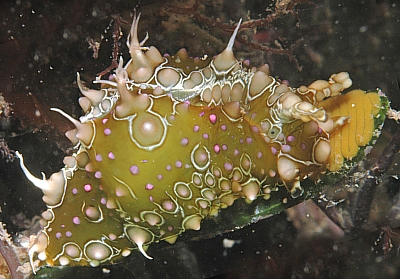
Dear Leanne & David,
Thanks for your photos. I have only included a few of them here but I think we can be pretty sure now that this species lays its egg ribbon in this zigzag pattern. Which is a useful bit of information when relationships within the sea hares [Aplysioidea] are being considered.
Best wishes,
Bill Rudman
Re: Petalifera ramosa with probable eggs
November 30, 2007
From: Leanne & David Atkinson
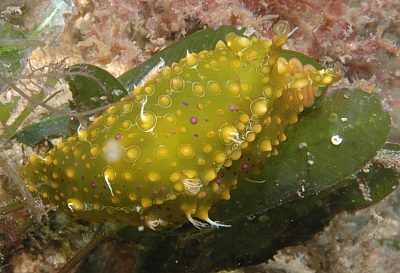
Concerning message #21206:
Dear Bill,
We found what we think is Petalifera ramosa laying eggs. If you look carefully you can see the start of an orange zigzag of eggs under its mouth. It was one of those photos that we didn't see what was going on until we put it on the computer screen. This Petalifera ramosa was hunched up so it didn't make a good shot and there were lots of others that looked like better photos to the naked eye. Because the egg laying wasn't particularly clear we didn't send it in earlier, thought it may have just been crawling over them. But we thought after seeing Ron Greer's shot with more detail that we should send it in as support to the theory that these are the type of eggs it lays. Now we know what we are looking for it will help. Mating photos show the head of one on the back of the head of another. Where do they lay eggs them from?
Locality: Fly Point, Port Stephens - Great Lakes Marine Park, Port Stephens, 8 metres, New South Wales, Australia, Pacific, 10 November 2007, Sandy bottom with scattered sponges, ascidians, kelp and seagrass. Length: approximately 70 mm. Photographer: Leanne & David Atkinson.
We've also included two other Petalifera ramosa photos showing them moving over seagrass. We wondered if they were feeding on the growth on the seagrass. These were taken on the 3rd November 2007 at The Pipeline, Port Stephens, New South Wales in 8 metres with water temperature 17 degrees celcius.
Thankyou as always for the wonderful work that you do on the forum we enjoy learning about these beautiful creatures.
Best wishes,
Leanne & David Atkinson
atk@hunterlink.net.au
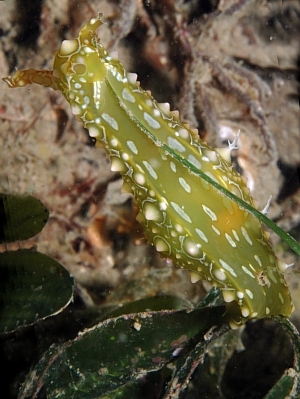
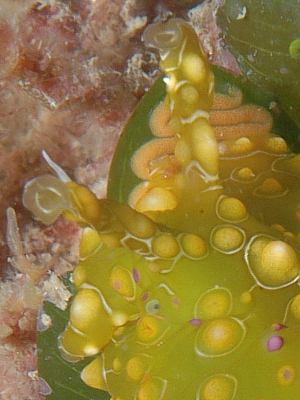
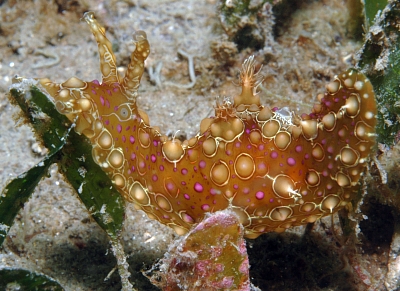
Dear Leanne & David Atkinson,
Thanks for these photos. The upper photo showing the egg ribbon on a blade of Halophila [see middle right close-up] certainly lends support to the idea that it is its egg ribbon. Your question about how they lay the egg ribbon raises an interesting question. Firstly I need to explain a little anatomy. In Petalifera the typical sea hare parapodia [see mantle cavity page] are partly fused together but there is a dorsal gap that can open a bit. You can see the gap in the upper photo in my message recording an animal from Lifou [#3687].
Now to mating and egg laying: Sea Hares, like all sea slugs, are hermaphrodites, but the penis is quite separate from the female openings. The penis is contained in a sac on the right side of the head while the female openings are situated at the front end of the parapodial cavity. Have a look at the drawing of the parapodial cavity of Stylocheilus [#7872], which is quite similar. I haven't got the reproductive openings labelled in that drawing but the black spot just in front of the parapodial cavity is the common genital opening and the curved line running forward to the right rhinophore represents an open groove down which the sperm is moved to the penis. So during mating the 'male' partner has to put the right side of its head near the common genital opening for copulation to occur.
How is the egg ribbon deposited? The egg ribbon is extruded from the common genital opening but I don't know how it is manipulated and attached in such a tight arrangement. In Sea Hares the tangled spaghetti-like tangle suggests that not much manipulation takes place but with Petalifera I suspect that like many nudibranchs, the ribbon is manipulated by the foot. If in your photo the egg ribbon is in the process of being deposited it would suggest that the head may wave back and forward to produce the zig-zag pattern. In Beeman's paper on Phyllaplysia taylori, which I mentioned in Ron Greer's message, the egg string is extruded from the common genital opening and then travels down the external sperm groove to the right side of the head where it is held by the lips and oral lappets and pressed to the substrate. The animal then moves its head from side to side to fasten the ribbon in the characteristic pattern. I think we can assume that Petalifera does exactly the same, but it would be worth adding it to your 'things to do' list, just to be sure.
Thanks for the question - if you hadn't asked I wouldn't have checked Robert Beeman's paper and found how they do it.
Best wishes,
Bill Rudman
Petalifera ramosa with probable eggs
November 29, 2007
From: Ron Greer
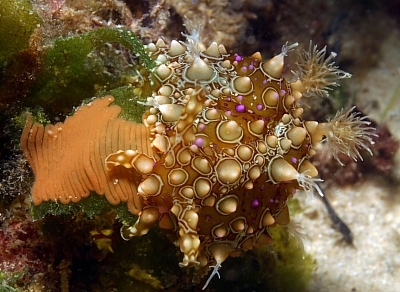
I have just read the message from Leanne & David Atkinson [#21017 ] about possible eggs of Petalifera ramosa and remembered a photo I had taken in 2005 showing very different eggs to that show by Leanne and David. The eggs I photographed are not typical of Sea Hares and it may be just coincidence.
Locality: Fly Point, Port Stephens, 8 m, NSW, 22 October 2005, Sand and Rubble. Length: 50 mm. Photographer: Ron Greer.
I was unable to actually see any egg laying, but the sea hare was stationary (almost completely covering the eggs) on the eggs for some minutes. It only stated to move away as I had tried to hard to see actual egg laying and disturbed it. I took the image as it began to move aside.
The second image is of the same animal where I had placed it for a image with good contrast
Regards and thanks for the wonderful site.
Ron Greer
diveimage@netspace.net.au
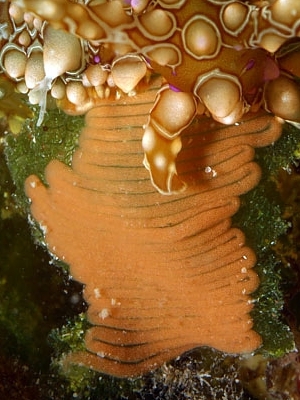
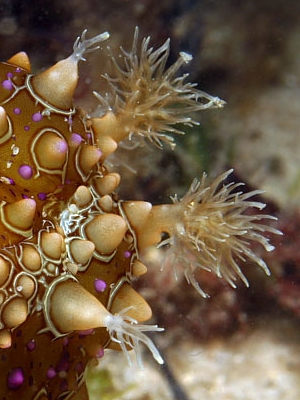
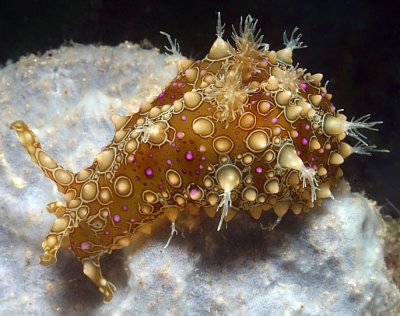
Dear Ron,
Thanks for the nice photos of Petalifera ramosa, and thanks for the photo of the egg ribbon which I am pretty sure are its. I can find no reference to its egg ribbon, but whereas species of Aplysia and Dolabella have a tangled spaghetti-like ribbon there are a number of species in related genera which have an egg ribbon much as in your photo. Dolabrifera brazieri [see message #56] is one of those, and Dolabrifera dolabrifera is reported to have a similar kind (Ostergaard, 1950). Beeman (1970) describes a similar ribbon for Phyllaplysia taylori and Ortea & Martinez (1991) describe a rough spiral egg ribbon for Petalifera petalifera which is attached as in these other species. What is nice about this egg mass similarity is that all of these genera fall into one subfamily of the Aplysiidae - the Dolabriferinae, which is generally accepted on anatomical grounds to be a valid phylogenetic group [see Klussmann-Kolb, 2004]. This is a nice example of the value of recording information on egg ribbons and other non-anatomical traits and behaviours that cannot be seen in collections of preserved animals.
-
Beeman, R. D. (1970) The anatomy and functional morphology of the reproductive system in the opisthobranch mollusk Phyllaplysia taylori Dall, 1900. The Veliger 13: 1-31.
-
Klussmann-Kolb, A. (2004) Phylogeny of the Aplysiidae (Gastropoda, Opisthobranchia) with new aspects of the evolution of the seahares. Zoologica Scripta 33: 439-462.
-
Ortea, J. A. and Martínez, E. (1991) El Orden Anaspidea (Mollusca: Opisthobranchia) en las Islas Canarias. Revista Academia Canaria de las Ciencias 3: 87-107.
-
Ostergaard, J.M. (1950) Spawning and development of some Hawaiian marine gastropods. Pacific Science, 4: 75-115
Best wishes,
Bill Rudman
Petalifera ramosa mating?
November 1, 2007
From: Leanne & David Atkinson
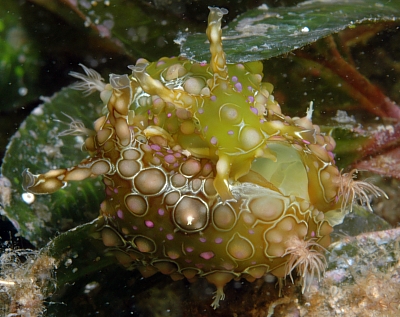
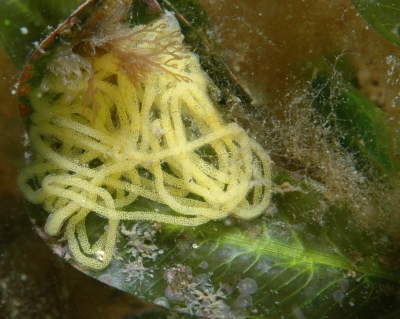
Dear Bill,
We found what we think is Petalifera ramosa mating, or about to mate, and they are two different colour forms. One is brown and one is green. There were quite a few of them on the green leaf like seaweeds. We thought this might be of interest both as a possible food item and also because of the two colours together.We also found some seahare type eggs on one of the leaf like seaweeds nearby and thought it may belong to them.
Locality: The Pipeline, Nelson Bay, Port Stephens, 8 metres, New South Wales, Australia, Pacific, 20 October 2007, Silty sandy bottom with scattered seaweed, sponges, algae, ascidians, bryozoans and gorgonians. Length: 50 mm. Photographer: Leanne & David Atkinson.
Thankyou as always for the wonderful work that you do on the forum..
Best wishes,
Leanne & David Atkinson
atk@hunterlink.net.au
Atkinson, L. & D., 2007 (Nov 1) Petalifera ramosa mating?. [Message in] Sea Slug Forum. Australian Museum, Sydney. Available from http://www.seaslugforum.net/find/21017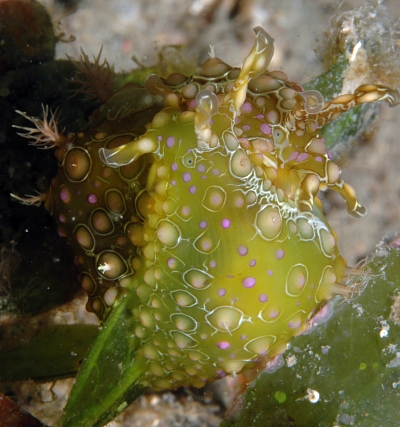
Dear Leanne & David,
Thanks for these great photos which show the shape and colour variability very well. You can also see the branching papillae in varying degrees of expansion - in some cases you wouldn't know there were extensile papillae hidden in the blunt tubercles at all. I assume that mating is on their minds.
It would be interesting to know what this species ate. The leaves in your photos are those of a sea-grass - probably a species of Halophila, but I am not sure if any sea hares actually eat flowering plants like the sea grasses. Some seem to be always associated with sea grasses, but I think it's a habitat rather then a food. For example Phyllaplysia taylori leaves 'feeding scars' on the Zostera it is always found on but from the literature it seems the assumption is that the scar is what the army would call 'collateral damage' caused as the animal scrapes the diatom and bacterial film of the sea grass leaf.
I am not sure if the egg mass is from this species. It is certainly a sea hare egg mass but I don't know if Petalifera ramosa has this tangled spaghetti-like egg mass like species of Aplysia, or a flattened egg ribbon like Dolabrifera.
Best wishes,
Bill Rudman
Petalifera ramosa and its papillae
May 10, 2006
From: Leanne & David Atkinson

Dear Bill,
Thought this behaviour might be of interest. We found Petalifera ramosa on a soft green weed that is called locally sea lettuce. When we moved the weed to get a clearer photo of the Petalifera ramosa it withdrew the filamentous branches and terminal papillae into the tubercles just as some nudibranchs withdraw their gills into a gill pocket.
Locality: Fly Point, Marine Reserve, Port Stephens, 10 metres, New South Wales, Australia, Pacific, 5th November 2005, Sandy bottom scattered sponges, soft corals, ascidians and bryozoans. Length: 120mm. Photographer: Leanne & David Atkinson.
See photos attached of the same Petalifera ramosa before being disturbed and while the sea lettuce is being held in place by a black gloved finger in the bottom left corner, for the photograph. What is the purpose of the filamentous branches are they gills?
Regards,
Leanne & David Atkinson
atk@hunterlink.net.au
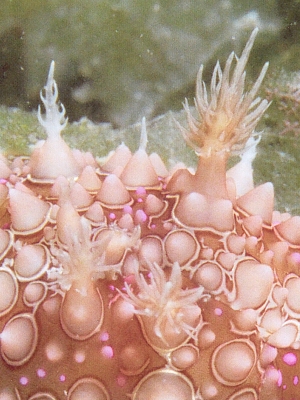
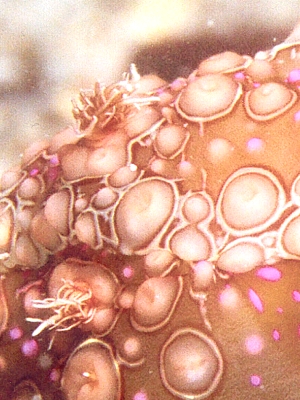
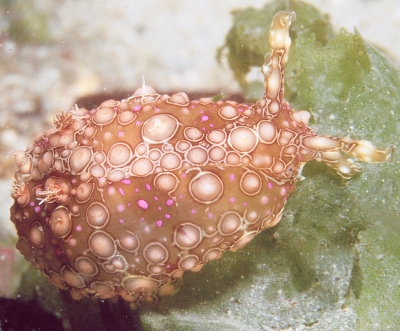
Dear Leanne & David,
Thanks for these photos which show the behaviour of the papillae so clearly. Although I don't think anyone has proved the papillae are secondary gills, the fact that they are filled with blood, and thin-walled, would suggest they are involved in gas exchange like a true gill. The body wall in most Sea Hares is quite thick and muscular so its unlikely that gas exchange can take place directly through the skin except in specialised 'thin' places like the papillae.
Many opisthobranchs have papillae and branching structures which are probably used as secondary gills. A secondary use for these structures is that they help camouflage the animal by breaking up its outline or silhouette and so make it less visible to likely predators. For example Tritoniopsis elegans looks spectacular and very obvious when photographed on a black background [see Fact Sheet] but in its natural environment it is almost invisible.
Best wishes,
Bill Rudman
Petalifera ramosa from the Caribbean
November 4, 2005
From: Les Wilk
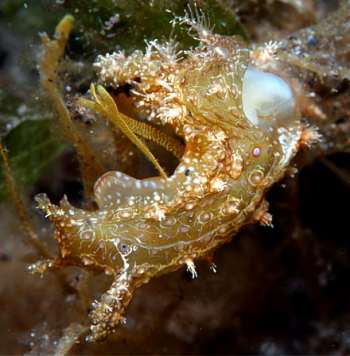
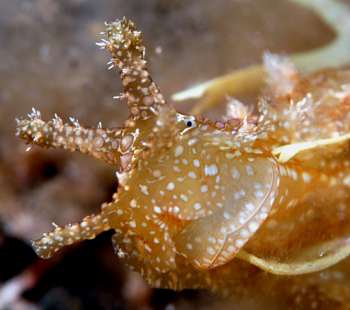
Hi Bill;
As a follow-up to the recent message [#15122] about Petalifera ramosa, here's yet another one from the Caribbean.
Locality: west side St. Vincent Is., Caribbean. Depth: 25 feet. Length: 1 inch. July 2003. sand, grass. Photographer: Keri Wilk
Les Wilk
wilk@reefnet.ca
Wilk, L., 2005 (Nov 4) Petalifera ramosa from the Caribbean. [Message in] Sea Slug Forum. Australian Museum, Sydney. Available from http://www.seaslugforum.net/find/15163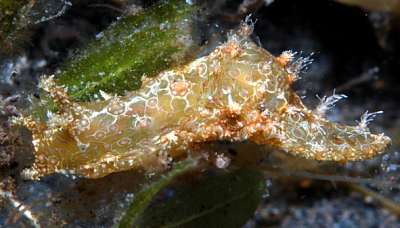
Dear Les,
Thanks to you and Kerri, for another interesting, and timely, contribution. It certainly educational to compare photos of species from two oceans like this. There are not that many species found naturally in both the Atlantic and the Pacific, and the few that are have obviously been separated from each other for a very long time.
Best wishes,
Bill Rudman
Petalifera ramosa from Port Stephens, NSW
November 2, 2005
From: Bruce Potter
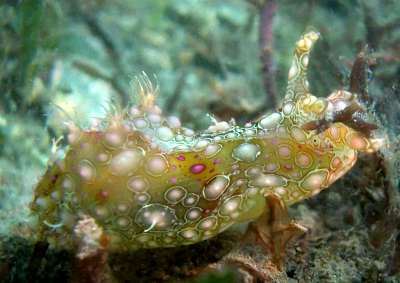
Bill,
I was diving with David and Leanne Atkinson last weekend when one of them turned up this little beauty. I had never seen Petalifera ramosa before and was fascinated by its jewel like patterns.
Locality: Nelson Bay, "Pipeline". Port Stephens, NSW, Australia. Depth: 7-8 meters. Length: 30 mm. 23 October 2005. Muddy, kelp, algae, weed, sponges. Photographer: Bruce Potter
It was at the site "Pipeline" in Nelson Bay. It was about 30mm long. There were numerous other Nudi's there including two other types of sea hare. This was at about 7 or 8 meters among kelp, weeds, sponges, algae's and mucky sand.
Bruce Potter.
bandppotter@bigpond.com
Potter, B., 2005 (Nov 2) Petalifera ramosa from Port Stephens, NSW. [Message in] Sea Slug Forum. Australian Museum, Sydney. Available from http://www.seaslugforum.net/find/15122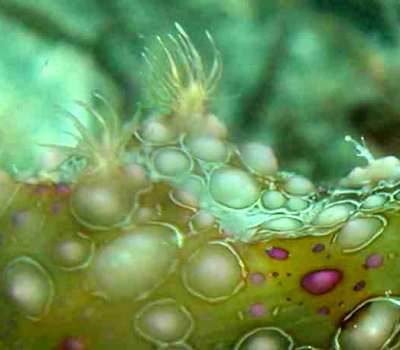
Dear Bruce,
"Jewel-like" is a good way to describe this animal. It is certainly hard to capture all its beauty in photographs.
Best wishes,
Bill Rudman
Petalifera ramosa? from Eilat, Red Sea
May 11, 2005
From: Binyamin Koretz
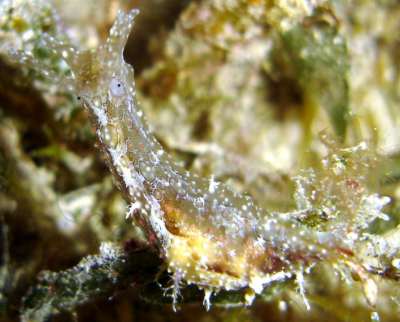
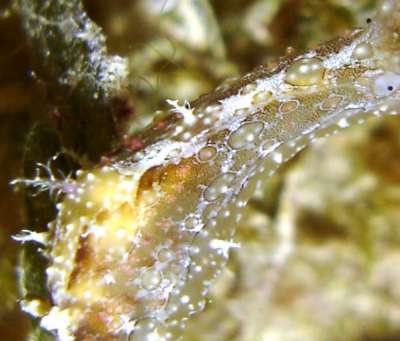
Hi Bill,
A beautiful little little sea hare, with many of the characteristics of Petalifera ramosa - but a very transparent shade of green.
Locality: Eilat, Village Beach, Israel. Red Sea (Gulf of Eilat). Depth: 22 m. Length: ca. 3 cm. 05 March 2005 night. sea grass, occasional coral heads. Photographer: Binyamin and Shulamit Koretz.
Best regards,
Binyamin
binyamin@koretz.net
Koretz, B., 2005 (May 11) Petalifera ramosa? from Eilat, Red Sea. [Message in] Sea Slug Forum. Australian Museum, Sydney. Available from http://www.seaslugforum.net/find/13298Dear Binyamin,
Yes this is Petalifera ramosa. It is a most beautiful little sea hare. They certainly range in colour from almost transparent, to a more opaque green. There doesn't seem to be any correlation between size and transparency.
Best wishes,
Bill Rudman
Re: sea hare eggs
May 11, 2005
From: Binyamin Koretz
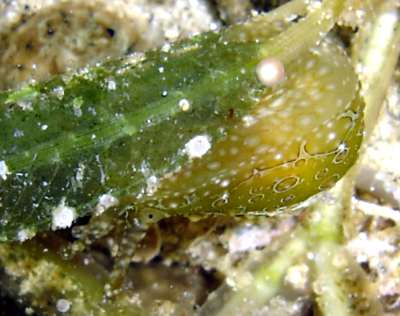
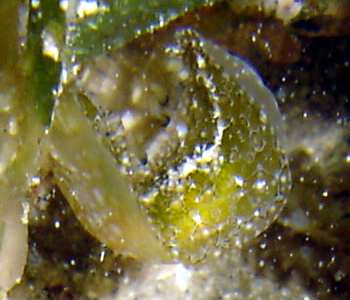
Dear Bill,
With reference to the eggs laid in rows on the sea grass [msg #13703] - this immediate area currently has a population of Petalifera ramosa. Perhaps that's the small sea hare which could have laid these eggs?
A couple of months ago [msg #13298] I sent you photos of nearly transparent specimens of what we assumed to be Petalifera ramosa from this area; since then, each sighting has been of increasingly opaque green individuals, as in the accompanying photo. I've also uploaded a photo showing one individual (disturbed by us) swimming by dorsoventral flexing as you previously mentioned [msg #9557 ].
Locality: Eilat, Village Beach, Israel. Red Sea (Gulf of Eilat). Depth: 24 m. Length: ca. 3 cm. 07 May 2005 (night). sea grass and patch reef. Photographer: Binyamin and Shulamit Koretz
Best regards,
Binyamin
binyamin@koretz.net
Koretz, B., 2005 (May 11) Re: sea hare eggs. [Message in] Sea Slug Forum. Australian Museum, Sydney. Available from http://www.seaslugforum.net/find/13738Dear Binyamin,
Petalifera ramosa sounds like a good answer to the egg ribbons. Sorry it has taken a while to post your earlier message, but better late than never. It is interesting how they are becoming more opaque in colour. As I said in a comment on your earlier message, being transparent or opaque does not seem to be size related.
Best wishes,
Bill Rudman
Petalifera ramosa from Saba,
January 27, 2005
From: Kelly Griggs
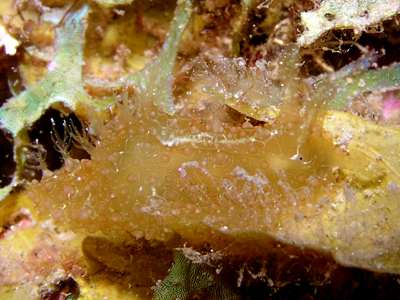
Hello,
I'm trying to ID this what I believe is a Sea Hare from my recent trip to Saba. From researching your site, the closest I can find is Stylocheilus striatus - can you confirm for me?
I am unsure of the exact dive site this was found, but as you can see from the pics, it was crawling on some algae, trailing slime as it went. I appreciate any help you can give!
Locality: Saba, Netherlands Antilles, Caribbean.
Depth: 45 feet approx. Length: 1/2 inch approx. 28 Dec 2004. on reef. Photographer: Kelly Griggs
Thanks,
Kelly Griggs
Georgia, USA
k_griggs@hotmail.com
Griggs, K., 2005 (Jan 27) Petalifera ramosa from Saba,. [Message in] Sea Slug Forum. Australian Museum, Sydney. Available from http://www.seaslugforum.net/find/12950Dear Kelly,
This is almost certainly Petalifera ramosa, which like Stylocheilus, is a Sea Hare, but has prominent multibranched papillae and low rounded tubercles.
Best wishes,
Bill Rudman
Petalifera ramosa from Bahamas
March 23, 2004
From: Lindsay Warren
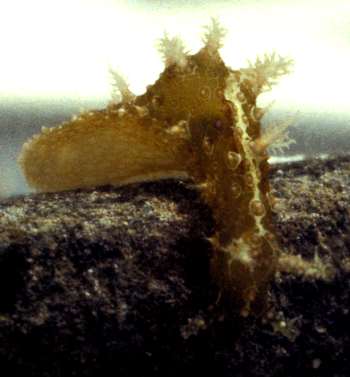
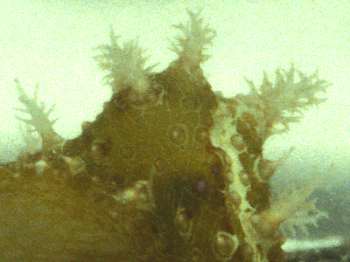
Dear Bill
I recently came across some old photos I had taken in the Bahamas when I first took up photography. Amongst these were various opisthobranch shots including several of Petalifera ramosa which I thought might be of interest even though they are pretty poor shots. On reading the various postings on the Forum I noted the discussion as to whether those occuring in the Caribbean did not normally have branched papillae on the tubercles [message #9544]. My photos clearly show that well 'tufted' tubercles do occur on the body and rhinophores of at least some Caribbean specimens.
Specimens found at Lee Stocking Island, Exumas, Bahamas. April 1979.
Length: approximately 30-40mm. Photos: Lindsay Warren.
Hope these are of interest
All the best
Lindsay
alldcl@compuserve.com
Warren, L., 2004 (Mar 23) Petalifera ramosa from Bahamas. [Message in] Sea Slug Forum. Australian Museum, Sydney. Available from http://www.seaslugforum.net/find/12500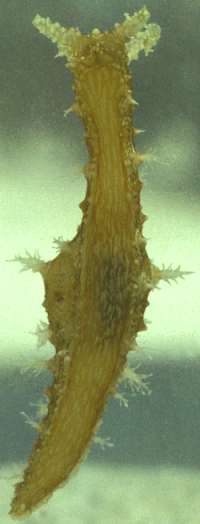
Dear Lindsay,
Thanks very much for these excellent photos. They may not win a photographic prize but they are extremely valuable to us. They certainly show an animal with very papillate tubercles. As I noted previously, Tom Thompson [#9557] described how the papillae of Jamaican animals he observed were able to fully retract, but I have still had difficulty finding photos of Caribbean animals which convincingly show the papillae on display.
Animals photographed when stressed, or studied preserved, often show no evidence of papillae. This is clearly a trap for those relying on such transient characters in developing identification keys and even in cladistic analyses.
Best wishes
Bill Rudman
Petalifera ramosa from Brunswick Heads
December 19, 2003
From: Denis Riek
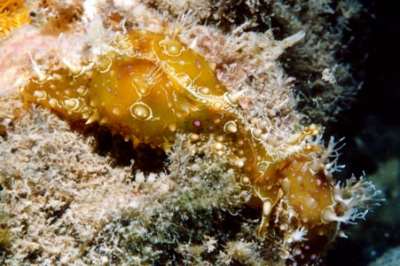
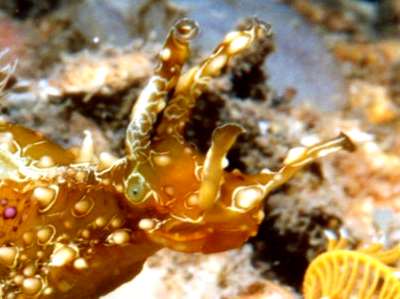
Dear Bill,
I have been snorkelling in the river for the last 3-4 months observing the marine life slowly returning [Brunswick Heads, nthn New South Wales,, Australia - see earlier message]. First the seaweed, then tunicates + small sponges, crinoids but no slugs. Then about a month ago they started to appear. Not just juveniles but all sizes. At the moment Dendrodoris fumata and D. denisoni are quite common while those that were common before have yet to appear. What amazes me is how quickly large individuals appeared as I really searched hard previously.
Although the range of species is low at the moment I have managed to sight 3 species I have not seen in the river before. Discodoris lilacina, Dolabrifera brazieri and Petalifera ramosa.
Petalifera ramosa were found on 10 December about 1/2km upriver opposite the trawler port, about 3-4 metres down the rockwall on rocks and high up in the long weed(Sargassum?). Observed several and they were all around 60-70 mm in length and beautiful little animals.
Regards
Denis Riek.
denisriek@hotmail.com
Riek, D., 2003 (Dec 19) Petalifera ramosa from Brunswick Heads. [Message in] Sea Slug Forum. Australian Museum, Sydney. Available from http://www.seaslugforum.net/find/11703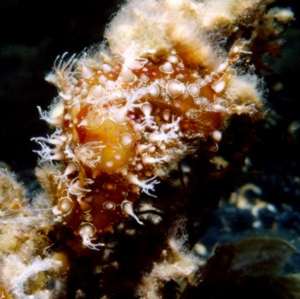
Dear Denis,
Thanks for these photos of Petalifera ramosa. The photo of the head reminds me of that strange Australian relative of the sea horse, the Leafy Sea Dragon. It is also interesting seeing the photo alongside showing the extended branched papillae waving around in the current. In this photo they look quite like a soft coral colony. Perhaps this is a camouflage we have overlooked?
Best wishes
Bill Rudman
Petalifera ramosa from Jamaica
October 19, 2003
From: Ross W. Gundersen
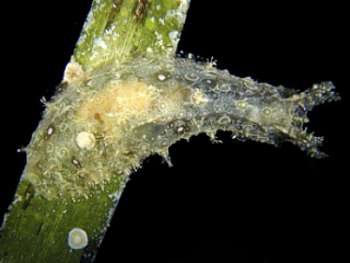
Dear Bill:
Here is another sea slug from Jamaica. As I said in my first message, all specimens were collected from St. Ann's Bay, Jamaica, West Indies. Most specimens were collected using a light weight dredge and photographed by R. Gundersen.
Here is Petalifera ramosa. Dredged at 1 m depth in Thallassia. Highly energetic slug which swims by coiling and uncoiling its body in response to the slightest touch.
The upper right picture fits the description of Petalifera ramosa by Marcus of Jamaican specimens.
The whole animal [lower right] fits the description of Phyllaplysia engeli from Marcus. Racemous extension of the tubercles were not observed in these specimens (36). There is another form which has reduced tubercles and meandering white lines.
Best wishes,
Ross
ross.gundersen@uwp.edu
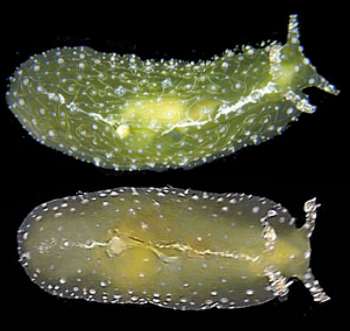
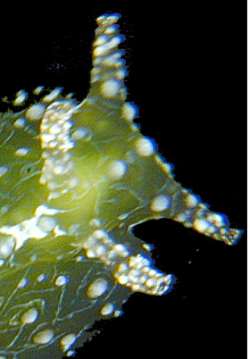
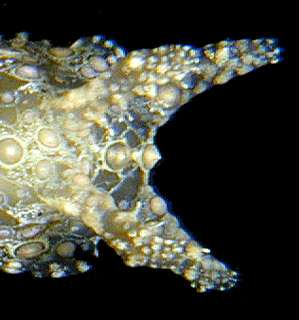
Thanks Ross,
Your upper right photo clearly shows the branched papillae which I had not been able to find any mention of in previous reports of the species from the Caribbean, so it certainly would seem that this is another species with a wide warm water distribution worldwide
Best wishes
Bill Rudman
Petalifera ramosa from the Dominican Republic
May 17, 2003
From: Elianny Dominguez
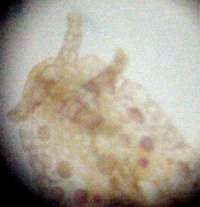
Dear Bill,
Here are some pictures of an opistobranch I found at one of my collecting sites [44f], on Udotea, on the Caribbean coast of the Dominican Republic, in a locality named La Caleta. It is 7 mm long and 2 mm width.
It is an anaspidean much like Dolabrifera dolabrifera. The posterior half of the animal is broader than the head region. On the first picture, you can see the head, with the rhinofores. In the second picture [lower left], you can see the coloration of the body. It has a lot of spots of different colors and sizes. And also, the dorsal opening of parapodial chamber. And on the third picture [lower right], you can see what got my attention. In the centre, you can see, what I guess are gills?? In the shape of a small anemone, with seven thin projections. This animal has two of this gills??, on both side of the parapodial chamber. One is bigger than the other. The one on the picture is the biggest one, and it is on the left side. The smaller one is on the right side. And they are both retractible. Is there a group of anaspideans with external and retractible gills, like the ones on Dorids?
Kind regards,
Elianny Dominguez.
eliannydominguez@hotmail.com
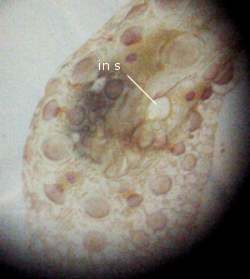
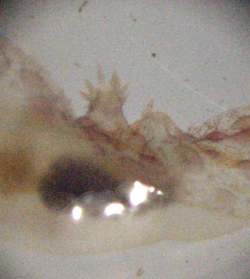
Dear Eli,
At 7mm long this is indeed a juvenile. It is Petalifera ramosa whih seems to have a world-wide distribution. The anemone-like 'gill' is the retractile papillae that are found at the tip of the conical tubercles that cover the body. Have a look at other messages on this page to see the papillae fully extended. I am not sure of the function of these papillae but perhaps they do have a function as secondary gills.
The 'real' gill is essentially internal, lying in what is left of the mantle cavity, which is itself inside the parapodial cavity. I have labelled the anterior 'inhalent opening' into the parapodial cavity.
Best wishes,
Bill Rudman
Petalifera ramosa from the Caribbean
April 3, 2003
From: Bill Rudman
Dear Colin,
In reply to your message I asked if Caribbean specimens of Petalifera ramosa had the characteristic branched papillae on the tubercles. This is answered by Tom Thompson (1977), whose paper you refer to, who describes animals from Discovery Bay in Jamaica and notes the 'spiky processes .... retractile into basal pits'. He also describes them swimming, when disturbed, by dorsoventral flexions of the whole body.
• Thompson, T. E. 1977. Jamaican Opisthobranch Molluscs I. Journal of Molluscan Studies, 43: 93-140.
Best wishes,
Bill Rudman
Petalifera ramosa from the Bahamas
April 2, 2003
From: Colin Redfern
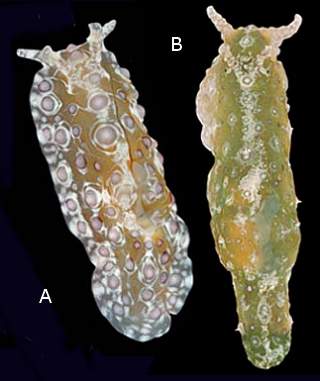
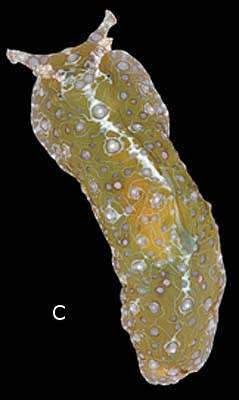
Dear Bill,
I noticed recently that your Factsheet for Petalifera ramosa doesn't include the Atlantic and Caribbean in its range of distribution.
Attached are photos of three specimens from Abaco, Bahamas, all of which were found amongst Thalassia that had been dredged from about 2.5m. A is an immature 8mm specimen from south of Pelican Cay, July 9, 1991. B is 24mm, from the lee side of Whale Cay on July 15, 1992, and C, 25mm, was collected by Rodger Bunnell near Don't Rock on August 22, 2002.
While the characteristic tubercles are very evident on the juvenile animal, they tend to be less conspicuous on adults from this area. All our records are from Thalassia beds, and the animals can swim by means of convulsive flexions when disturbed.
The species has also been recorded from the Florida Keys (Marcus & Marcus, 1962), the Caribbean coast of Colombia (Ev. Marcus, 1976), Jamaica (Thompson, 1977), the Canary Islands (Ortea & Martínez, 1991) and Cuba (Martínez & Ortea, 1991-1992).
I realize that this leaves unaddressed the question of whether all of these records do in fact refer to the same species described by Baba from Japan.
References:
• Marcus, Ev. & Er. Marcus. 1962. Opisthobranchs from Florida and the Virgin Islands. Bulletin of Marine Science of the Gulf and Caribbean, 12(3): 450-488.
• Marcus, Ev. 1976. Opisthobranchia von Santa Marta, Colombia. Studies on Neotropical Fauna and Environment, 11: 119-150.
• Thompson, T. E. 1977. Jamaican Opisthobranch Molluscs I. Journal of Molluscan Studies, 43: 93-140.
• Ortea, J. & E. Martínez. 1991. El orden Anaspidea (Mollusca: Opisthobranchia) en las Islas Canarias. Revista de la Academia Canaria de Ciencias, 3(4): 87-107.
• Martínez, E. & J. Ortea. 1992. Primeros datos sobre el orden Anaspidea (Mollusca: Opisthobranchia) en la Isla de Cuba. Revista de Biología de la Universidad de Oviedo 9-10: 95-111.
• Redfern, C. 2001. Bahamian Seashells: a Thousand Species from Abaco, Bahamas.
Best wishes,
Colin
bahamianseashells@att.net
Thanks Colin,
Your photos certainly look like the Indo-West Pacific species, and Eveline Marcus (1972) considered the anatomical differences to be minor. One obvious difference is that the Caribbean animals seem to lack the conspicuous branched papillae which arise from the tubercles. Are they just contracted in your photos? Marcus's illustration is of a Japanese animal so that doesn't help much. The record from from the Canary Ids (Ortea & Martinez, 1991) also needs examination as the illustration doesn't indicate the prominent tubercles or the papillae which give it its name ramosa.
Best wishes,
Bill Rudman
Petalifera ramosa Baba from Japan
February 5, 2003
From: Jun Imamoto
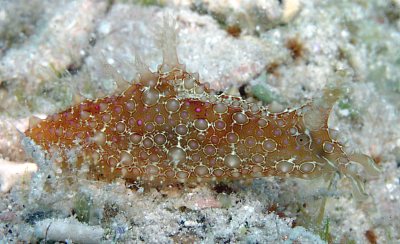
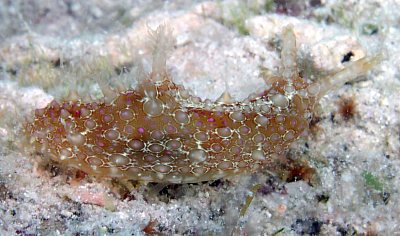
Here is a sea slug, which I think is Petalifera ramosa, which I observed in 2002.
Okinawa, Kerama Islands, Japan. 9 Mar 2002. Size approx: 27mm. Depth: 20m. Temp: 22 C. Photos: Jun Imamoto
Best Regards,
Jun Imamoto
http://umiushi.zive.net/
imamoto@wips.co.jp
Imamoto, J., 2003 (Feb 5) Petalifera ramosa Baba from Japan. [Message in] Sea Slug Forum. Australian Museum, Sydney. Available from http://www.seaslugforum.net/find/9018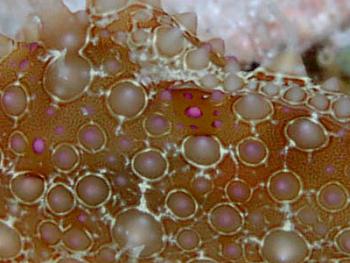
Thanks Jun,
Yes this is definitely Petalifera ramosa. The distinctive cone-like tubercles and brilliant pinkish colour are very characteristic of this species.
Best wishes,
Bill Rudman
Petalifera ramosa on Sea Grass
February 8, 2001
From: Erwin Koehler
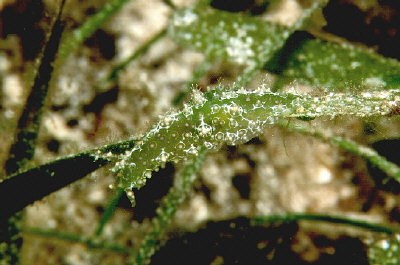
Dear Bill,
In reference to Bernard Picton's suggestion that perhaps Petalifera may live on algae and Phyllaplysia on Sea Grasses, here is a photo of Petalifera ramosa on something I would call Sea Grass. It is from the Philippines, Cabilao Is., depth 15m, size about 1,5 cm, May 2000.
The photo was taken by Georg Heinze [GeorgHeinze@t-online.de
Cheers
Erwin
Medslugs.Koehler@t-online.de
Koehler, E., 2001 (Feb 8) Petalifera ramosa on Sea Grass. [Message in] Sea Slug Forum. Australian Museum, Sydney. Available from http://www.seaslugforum.net/find/3735Dear Erwin,
Definitely Sea Grass and definitely Petalifera. It will be interesting to know if anyone has found Phyllaplysia on algae.
Best wishes,
Bill Rudman
Re: Petalifera from Pemba Island
February 7, 2001
From: Ron Velarde
Dr. Rudman,
In your discussion of Petalifera vs. Phyllaplysia, you mention Petalifera taylori from southern California. The original description and all records that I am aware of list it as Phyllaplysia taylori. Have there been some new studies that revise the original generic placement?
Ron Velarde
rgv@sdcity.sannet.gov
Velarde, R., 2001 (Feb 7) Re: Petalifera from Pemba Island. [Message in] Sea Slug Forum. Australian Museum, Sydney. Available from http://www.seaslugforum.net/find/3751Dear Ron,
Sorry. No great taxonomic insights - just my brain in neutral. I will change my error straight away.
Bill Rudman
Petalifera from Pemba Island
February 4, 2001
From: Bernard Picton
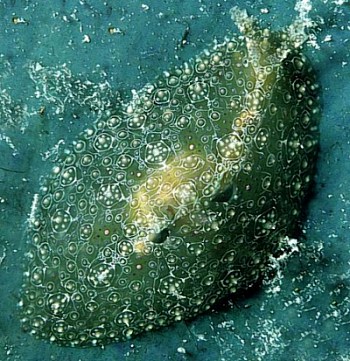
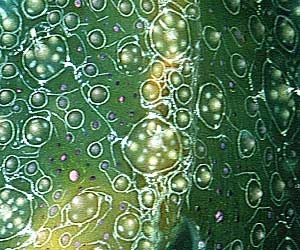
Hi Bill,
Here are a couple of scans of an animal which I take to be a Petalifera
species. Having read your comments on Phyllaplysia and Petalifera I see that there is debate over these genera. This animal was found at night on a large
frond of algae (possibly a brown alga). It has tubercles and pink and purple spots which are very similar to those of Petalifera ramosa, despite the difference in body shape. Comparing it with your Phyllaplysia species (which seem to be on sea grasses) I wonder if Petalifera species are on algae?
Bernard
bernard.picton.um@nics.gov.uk
Picton, B., 2001 (Feb 4) Petalifera from Pemba Island. [Message in] Sea Slug Forum. Australian Museum, Sydney. Available from http://www.seaslugforum.net/find/3683Thanks Bernard,
I think your animal is what I am calling Petalifera ramosa from the Western Pacific. In your enlarged photo of the tubercles, the largest have small papillae or branches at the tip which match those shown more extended in some photos I am posting separately of animals collected at Lifou in November.
Concerning your suggestion that Phyllaplysia is found on sea grasses and Petalifera on algae I would tend to agree, but I think we will need more records. I have had a quick look at my records of Phyllaplysia and it seems retricted to sea grasses but I haven't enough of Petalifera to say anything sensible.
Robert Beeman studied the Californian species Phyllaplysia taylori quite extensively, and in a summary (Beeman, 1968) he reported that it fed on the algal film (mainly diatoms) over the leaves of the sea grass Zostera. But I don't know of any studies on other species of either Phyllaplysia or Petalifera.
Beeman, R.D. (1968) Part Two. The Anaspidea. The Veliger, 3 (Supplement): 87-102.
Best wishes,
Bill Rudman
Petalifera ramosa from Lifou
February 4, 2001
From: Bill Rudman


To accompany Bernard Picton's message about Petalifera ramosa from East Africa, here are some photos I took of one from Lifou, Loyalty Ids, New Caledonia, November, 2000. It was 36mm long, and collected at 23-34m on the green alga Microdictyon.
Best wishes,
Bill Rudman.
Petalifera ramosa - additional images
May 19, 2000
From: Ron Greer

Dear Bill,
Late last year I sent you a couple of images of Petalifera ramosa from Fly Point [Port Stephens, NSW, Australia]. Those images were scans from print film. At the time I also shot some slide film and have only recently been able to have them scanned. Attached are two additional images that may be of interest. The colour is much greener than the print film.
Regards, Ron.
diveimage@i-o.net.au
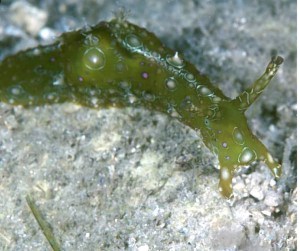

Dear Ron,
Thanks very much. It is a really spectacular animal. My son, who is a design student, just walked in and thought I had been playing on the computer and 'made up' the colours in your photo. Even after my denials I don't think he is totally convinced they are real.
I'm very glad you sent these in, they are the only good photos I have ever seen of this species.
Best wishes,
Bill Rudman.
Re: Petalifera ramosa from New South Wales
December 7, 1999
From: Ron Greer
Dr Rudman,
I estimate the animals we saw to range in size from about 5-8cm.
You may also like to know that Melinda (my dive buddy) and I have count of the species of sea slugs we saw in Port Stephens and under the Tathra wharf over the 12 dives we did.
Port Stephens - 22 ?
Tathra Wharf - 6
Ron Greer
diveimage@i-o.net.au
Greer, R., 1999 (Dec 7) Re: Petalifera ramosa from New South Wales. [Message in] Sea Slug Forum. Australian Museum, Sydney. Available from http://www.seaslugforum.net/find/1642Thanks Ron.
1999 (Dec 7). Comment on Re: Petalifera ramosa from New South Wales by Ron Greer. [Message in] Sea Slug Forum. Australian Museum, Sydney. Available from http://www.seaslugforum.net/find/1642Petalifera ramosa from New South Wales
December 3, 1999
From: Ron Greer
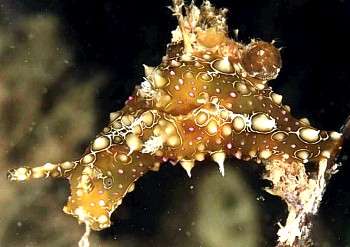
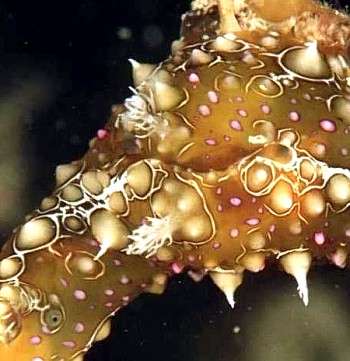
Dr Bill Rudman,
I am a amateur u/w photographer that has just finished a two week diving holiday (with my buddy Mrs Melinda Hutchison) from Port Stephens to Eden on the New South Wales coast. The majority of dives were at Fly Point in Port Stephens where I found the best variety of sea slugs I have seen there in years. There were three things that I photographed there that maybe of interest to you.
One is the sea hare Petalifera ramosa [see page 149 in Helmut Debelius' book Nudibranchs and
Sea Slugs. This publication states the distribution to be Japan to Indonesia. Port Stephens maybe a range extension?
We found quite a few at night high in the sea weed in about 5-8 metres on 21 Nov 99.
I hope this information is of use and await your reply.
Regards
Ron Greer
diveimage@i-o.net.au
Greer, R., 1999 (Dec 3) Petalifera ramosa from New South Wales. [Message in] Sea Slug Forum. Australian Museum, Sydney. Available from http://www.seaslugforum.net/find/1635Dear Ron,
Thanks for the photo. Yes this is Petalifera ramosa which was first described from Japan. I certainly haven't any reliable records of it from New South Wales so this is an interesting find. I have found it in New Caledonia and suspect it is probably widespread in at least the the west Pacific and probably the Indian Ocean as well.
Can you give me any indication on how long the animals were?
Best wishes,
Bill Rudman.
